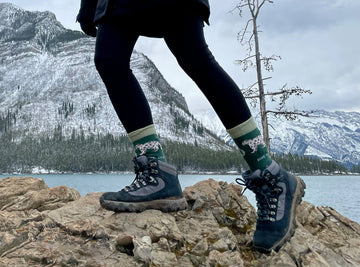Measure your feet accurately and regularly
Many people wear the same shoe size for years and then forget to check their size, but age, injury, pregnancy, activity level, etc. can all change the size and shape of their feet, so it’s essential to measure your feet before buying hiking boots.
To find the right style:
Measure both feet while standing, ideally when your feet are a little swollen.
Measure your feet at home with a ruler and paper or consult a shoe professional who can measure your foot length and arch length (the distance from your heel to the base of your toes).
Regular measurements will ensure that your boots fit your current foot structure, not the size they were years ago.
The right hiking boots aren’t just about looks and durability, it’s also about ill-fitting boots that can ruin your hike and cause pain, fatigue, and blisters.
How to know if hiking boots fit properly
Hiking puts your feet through long miles, rough terrain, and constant impact. A good fit ensures:
1. All day comfort
2. Stable footing even on uneven surfaces
3. Reduces the risk of blisters and injury
4. Support ankles, arches, and toes
That’s why “how should hiking boots fit” is one of the most important questions hikers should ask before buying.
1. Toe Room: Leave a Thumb’s Width
Your toes should never touch the front of the boot. You need space to prevent bruising on descents.
📏 Fit Test: Stand up straight in unlaced boots, slide your foot forward, and check if there’s a thumb’s width behind your heel.
2. Heel Fit: Snug, Not Slipping
Heel lift causes blisters. When walking, your heel should stay firmly in place without rubbing.
🧵 Try a heel-lock lacing technique to secure the back if there's minor lift.
3. Midfoot support: Firm handshake
The arch area should feel gently hugged—not squeezed. It supports your stride and balance.
🚫 Numbness = too tight
💨 Smooth = too loose
4. Ankle collar: Safe fit and padded
Especially in women’s hiking boots, the ankle collar should fit but still allow for flexibility, too tight and you’ll rub, too loose and you won’t have as much support on tricky terrain.
5. Right tips before you buy
To find a comfortable and snug pair of hiking boots, keep these tips in mind before trying them on.
🧦 Wear your regular hiking socks
Wearing your regular hiking socks will give you an accurate idea of how your boots will fit and be comfortable.
📍 Try on your boots in the afternoon
Your feet tend to swell slightly throughout the day, especially in the afternoon or evening. Trying boots during this time helps avoid buying shoes that feel fine in the morning but become tight later.
🥾 Walking up and down the mountain
Replicating real-life trail conditions by walking on slopes and uneven surfaces when trying on boots will help you see how well the boots support your feet on different terrains.
✅ Try it with both feet
Many people have one foot slightly larger than the other. Always try both boots to ensure a comfortable fit for each foot and avoid buying boots that only fit one foot well.
6. Common Fit Mistakes—and How to Avoid Them
❌ Choose the size of your regular sneakers
✅ Hiking boots usually need to be a half size larger to accommodate thick socks and allow more room for the toes on the descent.
❌ Sit down and try to fit
✅ Be sure to stand up and walk around. Your foot shape changes with your weight and movement.
❌ Ignore the effects of socks
✅ Try wearing boots with hiking socks you plan to wear on the trail.
❌ Expect your boots to break in
✅ Fitted hiking boots should feel 80% comfortable right out of the box.
Final fit checklist ✅
* Wiggle room in the toes;
* Heel doesn’t lift when walking;
* Midfoot feels stable;
* No pressure points or hot spots;
* Ankle collar feels comfortable;
Find the Right Fit—and Hit the Trail
Shop the anjoufemme women's hiking boots for the perfect balance of space, structure and support. Because the right boot makes all the difference in your hiking experience.






